 Western Kenya is full of cultural adventures and experiences for travellers looking to get in with the locals and wildlife. Here is a brief overview of what awaits to the West.
Western Kenya is full of cultural adventures and experiences for travellers looking to get in with the locals and wildlife. Here is a brief overview of what awaits to the West.
The Luhya community is well known for a traditional dance called Isikuti. It is named after the main instrument played during the dance. The men and women dance in pairs as the Isikuti is played along with bells and whistles. Be part of the fun while on your tour of western province in Kenya.
Bull fighting is a very important sporting event in the Luhya community. These bullfights are not the same as you will see in Spain where a Matador is pitted against a bull. These fights are between two animals while spectators watch and blow traditional horns in excitement.
Bullfights are held all year long. The bulls that fight represent individual villages and the winner brings prestige to the villagers, this is part of the reason these fights are so important to the community. Thronged by excited spectators, the bulls lock horns and fight until one bull turns and runs. The winning bull is led around the field in a victory lap. This impressive spectacle represents a significant cultural link between traditional African cattle culture and the art of bullfighting as practiced throughout Southern Europe.
The Kakamega Forest is a must see for nature lovers. It is made up of central African lowland species but because of its elevation it also has highland species in certain areas. This makes the forest unique in the region. You will see a great variety of birds throughout the forest; it’s an amazing place to visit.
There are a lot of agricultural activities that go on in the West. Maize farming is a big part of many households – it is there main source of food and income. You will also see sugar plantations and coffee and tea farms as you travel. If you get close the border with Uganda you can see tobacco plantations, which are a large source of income for the surrounding communities.
Taking a few days from your Mombasa vacation to experience more of the West will yield an experience you won’t soon forget. Kenya is a country full of beauty and unique adventure. Book your flight today or call us today to talk about rates and travel times.
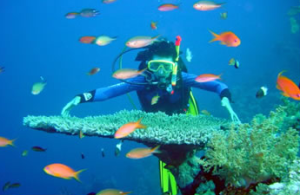 With the world’s second largest barrier reef and all sorts of sea life to be found off the Kenyan coast, diving in Mombasa is a must for enthusiasts. The Mombasa North Coast dive area is a paradise for beginners as well as for experienced divers. The floras and faunas of the Indian Ocean reveal the opportunity to see Sea Turtles, Morays, Giant Wrasse, Groupers, and Whitetip Reef Sharks. With a bit of luck you’ll also be able to see mantas and whale sharks.
With the world’s second largest barrier reef and all sorts of sea life to be found off the Kenyan coast, diving in Mombasa is a must for enthusiasts. The Mombasa North Coast dive area is a paradise for beginners as well as for experienced divers. The floras and faunas of the Indian Ocean reveal the opportunity to see Sea Turtles, Morays, Giant Wrasse, Groupers, and Whitetip Reef Sharks. With a bit of luck you’ll also be able to see mantas and whale sharks.
From October to March Kenya has to be one of the very best places on earth to see Whale Sharks. These gentle giants are amazing to behold. Being the largest fish in the ocean they are actually easy to spot from a plane, so many diving companies will send up a spotter to decide where best to dive to see them.
If you’re looking for the Reef Sharks you’ll have the most luck at sites such as Shark Point 1 and Taa. They are less often seen at other sites except for some of the deeper ones. The sharks are around all year so you can plan your trip around the Whale Sharks and not have to worry that you’ll miss anything.
Severe penalties exist in Kenya for anyone found hunting or killing sea turtles or trading in sea turtle products. As a result turtles can be seen all year round at many dive sites in the area. Swimming with a sea turtle is an experience that can hardly be described in words; it is something every diver should make the time to do.
The reef in the marine park area is protected so the coral here is in good condition with very little in the way of damage. Outside of the marine park occasional damage is noticed but this is rare. Mombasa is very lucky to have many varieties of ray including the favorites: Manta Rays and Eagle Rays. Watching them sweep along the ocean floor or just above the coral is an amazing site.
You’ll also have the opportunity to see: a variety of Eels including Moray and Snake, Lobsters, Crabs, Shrimp, Octopus, Cuttlefish, Squid, Grouper, Barracuda, and possibly even Billfish. That’s not to mention all the small coral reef fish – too numerous to name and absolutely beautiful to see.
Mombasa is a divers paradise. It is beautiful and exotic while still remaining accessible. When booking your diving adventure trip, call around to the different diving companies to figure out what area is best for you from there you can book your perfect hotel.
Whether you’re looking to travel to Mombasa, Kenya for some well deserved rest and relaxation or simply for business, the accommodation options in the North Coast are ample and cater for all pocket sizes.
For the hedonistic traveler, there are a number of four and five star beach resorts that line the North Coast of Mombasa, some of which offer an all-inclusive deal for their guests. Located on wide stretches of palm fringed, powdery white sandy beaches, these Mombasa resorts have an atmosphere reminiscent of Swahili culture. With air-conditioned, beautifully designed deluxe suites and standard rooms either facing the sea or lush gardens, these luxurious hotels have a wide selection of well equipped rooms to choose from. The rooms also generally are equipped with satellite TV, mini bars and a safe. There are also conference facilities available for those who are in Mombasa on business.
Most Mombasa beach resorts have more than one pool and a choice of bars and restaurants that are open throughout the day. Entertainment is provided by local bands and traditional dancers while you enjoy your dinner. Hotels such as the Sarova Whitesands and Serena Beach Hotels have in-house health and beauty spas which offer a variety of treatments to help you relax and rejuvenate. There are also gyms, tennis and squash courts, yoga and aerobics classes available on the hotel grounds. For those travelling with children, there are children’s clubs and activities organized to help keep the little ones entertained while you enjoy your sporting activities.
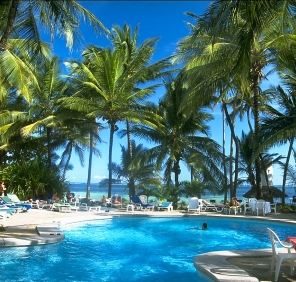 If you’re not fussed about expensive Egyptian cotton sheets and Italian tiled bathrooms and are looking for a more homely environment away from the crowds, there are self-catering, fully equipped beach cottages available in Mombasa. In most cases, you can hire a cook cum cleaner at a negotiable, reasonable rate. These are ideal for groups of people or families travelling together.
If you’re not fussed about expensive Egyptian cotton sheets and Italian tiled bathrooms and are looking for a more homely environment away from the crowds, there are self-catering, fully equipped beach cottages available in Mombasa. In most cases, you can hire a cook cum cleaner at a negotiable, reasonable rate. These are ideal for groups of people or families travelling together.
For those looking to escape the beach culture, Mombasa has a number of hotels located in the heart of town such as the colonial style Castle Royal Hotel located just ten minutes from Mombasa’s Old Town and the tourist hot-spot Fort Jesus. Furnished and self catered apartments such as the elegant Tamarind Village Apartments are ideal for business travellers looking for a quiet environment or if you’re planning to be in Mombasa for a longer period.
Mombasa travel appeals to all interests and all sizes of pocketbooks. History buffs are thrilled by the intact ramparts and walls of the 16th century Fort Jesus and the narrow streets of Old Town, water sports junkies get to dive in some of the world’s best dive sites and adventure seekers are thrilled to watch wildlife at play at the famed Kenyan game parks.
mombasa beach
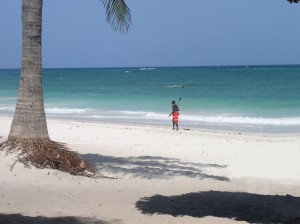
Mombasa - White Sandy Beaches
Mombasa is an island, connected to the mainland by causeways, bridges and ferry. As you approach from the ocean, one of the most remarkable sights is the imposing Fort Jesus which was built to guard the harbor entrance and solidify the presence of the Portuguese along the Kenyan Coast.
In a spectacular sound and light show held on certain nights of the week, visitors are ushered to their seats by the light of flaming torches and actors recreate the battles carried out around the Fort. A dinner by starlight in the old courtyard finishes a memorable evening.
The city is principally a port but to its north and south are wide stretches of sun-drenched white sandy beaches and a wide variety of hotel resorts ranging from sumptuously luxurious to basic no-frills.
Mombasa has become important as a safari hub and many tourists come to the beach before or after a safari to relax. However, enticed by fabulous water sports, spectacular marine parks and sunsets on an authentic Arab dhow, it is likely they do not chill for very long.
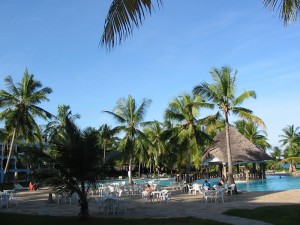
Mombasa Hotels
Although the top end beach resorts offer every luxury from champagne breakfasts to pampering spas, those who want privacy opt for self-catering cottages found along the coast. These range from fairly basic lodgings to high-styled thatched cottages which come equipped with house staff, tennis courts and swimming pools. There is something for everyone in Mombasa.
Up and down the coast is a string of islands on which are ruins of mosques, tombs and forts. Once home to several thousands, Gedi, which lies two hours north of Mombasa, almost overnight become a lost city.
Further north, the sand dunes in Lamu conceal long deserted settlements thought to be more than a thousand years old. Lamu’s medieval stone town, much visited by archaeological buffs, is one of the last few intact remnants of the Swahili civilization which was the dominant force until the British arrived.
Along with the beaches, the game parks are the most visited attractions in Mombasa. Visit the elephant sanctuary in nearby Shimba Hills Reserve or go further afield to one of six national parks which cover more than 24,000 sq kilometers in total.
In renowned Maasai Mara, one of the most breath-taking sights is the annual migration of up to one and a half million wildebeest. This is most spectacular in August. Otherwise, there are giraffe, zebra, gazelle, elephant, eland, ostrich, buffalo, ostrich, kongoni, topi and lions, lots of them, to look out for.
Adventure awaits you in Mombasa. The dry season, from July to October, is the best time to visit as the temperatures are milder and the air is not so humid. Peak Mombasa travel period takes place from December to March, which are also the months when the water is clearest for diving, snorkeling, and deep-sea fishing.
So much awaits you on your Mombasa holidays. Come face to face with splendid wildlife on their home territory, be hedonistic in a five star spa, feel at home away from home in a rented cottage, swim with dolphins and whale sharks and satisfy your inner history buff by visiting 500 year old ruins and lost cities.
Mombasa’s proud history dates thousands of years back to when it was identified as a port, then known as Tonike, in a sailing guide in 80AD. The Arab influence is very pervasive here in the minarets and white-washed mosques of the Old Town. But as one of the world’s great cross roads, a multitude of accents can be heard and everywhere there is a hustle. Both new and old sections – defined by the iconic Mombasa Tusks and the grand Fort Jesus – are worth visiting.
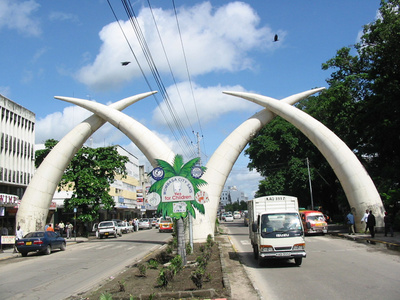
Mombasa Tusks
Discover the fascinating Old Town on your Mombasa holiday, walk its narrow streets in shadows cast by tall houses with elaborated carved balconies, buy a coffee from an Arab street vendor poured from tall long-beaked copper pots.
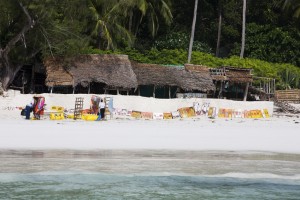
Marketplace on Mombasa Beach
Snap images of white-washed mosques standing side by side with African markets, meander through stores selling old coins, curios, silverwork, Lamu style furniture and a pharmacopoeia of scents which reach heavenward. Watch beautiful Hindu women stroll by in brightly colored saris, Arabs in beaded hats and the Swahili in long white robes or beautifully patterned kangas worn by the women.
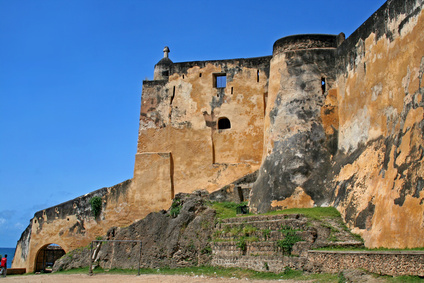
Fort Jesus in Mombasa, Kenya
A must on any itinerary during your holiday in Mombasa is to spend some time at the immense and weathered Fort Jesus. Its guns still point out towards the harbor and there is a worthwhile museum that deals with the history, culture and architecture of the coast. Among its interesting exhibits are relics from Portuguese shipwrecks and coats of arms of Portuguese commanders carved in stone.
Continuing that military tradition, did you know that the British code-breaking outfit of Bletchley Park had an outpost here in Mombasa? The Kilindini code breakers operated out of Allidina Visram school for several years gathering major intelligence during the 1940’s. See “The Emperor’s Codes” by Michael Smith for a more detailed history.
Relax on a sunset and dinner cruise on a Tamarind dhow and dance under African skies after a first class candlelit dinner. Or choose a lunch cruise which sails from Kilindini Harbor to a creek for a lazy post seafood lunch swim.
While safaris are the main draw in Mombasa, ensure there is sufficient time on your Mombasa holidays to enjoy the beach life on either the North or South coasts. Here are miles and miles of white coral sand fringed by palm trees and hotels and resorts of every caliber from makuti palm-leafed African style cottages at the Severin Sea Lodge to the ancient Arab Lamu-style architecture of the Serena Beach hotel.
From the north, head towards Malindi Marine park where the corals and rich and varied. From Malindi, big game fishing boats pull out to catch marlin and sailfish which run in the deep ocean water beyond the reef.
Along the South Coast are the drop dead gorgeous Indian Ocean Beach Club and Leopard Beach Resort. From the South coast, it is easy to get to the unique Shimba Hills National Park and the Kisite Marine National Park or visit the inland African villages of Kwale.
Be captivated by adventure and romance on your next Mombasa holiday and if time runs out, you can always come back again.
MOMBASA KENYA IS LIVING CULTURE
Mombasa Kenya is laidback, friendly, steeped in history and totally unpretentious. It is living culture. A coral colored fort with cannons peeping out from its bastions greets visitors coming in from the ocean. Dhows are still moored in its harbor and it is one of the oldest settlements in East Africa.
In an old town of narrow streets and Swahili architecture, business goes on as usual in the shadow of the military Fort Jesus which bears witness to many bloody battles for control of this ancient trading port.
Historic port
A long history of maritime trade with Arab nations spanning a millennium and prominent influences of Islamic civilization are seen in more than fifty mosques in Mombasa Kenya.
Ethnically, however, Kenya’s second largest city is more diverse than the capital city of Nairobi. There are also large numbers of Sikh and Hindu temples, Catholic and Anglican churches.
Swahili culture
Over its history, the Portuguese, the fierce Zimba tribe and the Arabs of Oman have all laid claims to this city. British rule started in 1895 and today Mombasa Kenya remains one of the most important links between Africa and the outside world. Despite all these external influences, it is the Swahili civilization that lends that special air and strong sense of identity.
The Swahili coast has such a distinct culture from the rest of Kenya in large part because of the Maungu Plains which separate the country’s interior from the Indian Ocean. The Swahili women are either outfitted in black from head to toe in the buibui or in the brightly colored multi-patterned kanga outfits. Men are dressed in the white kanzu garments with long sleeves.
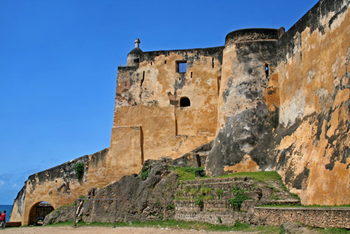
Fort Jesus, Mombasa Kenya
Fort Jesus Museum
The 16th century Fort is one of the largest draws in Mombasa Kenya. Previously built to protect the Portuguese from Turkish invaders, it is now a museum which houses exhibits depicting more than 700 years of Mombasa’s history.
Displays include many exhibits of Chinese porcelain, Persian and Portuguese glazed ware and military artifacts from its site as well as from ancient sites such as Gede and Ungwana. Parts of the Portuguese frigate, Santo Antonio de Tanna, which sank off the coast during a siege, and extensive relics recovered from the wreck are viewed here. .
There are replicas of cannons in its many battlements and within its compound, displays at the Omani House offer fascinating insights into Swahili life. The great water cistern, barrack and storage rooms remain intact and you can grab scenic views of the Old Town from the northwestern corner of the fort.
While walking around Old Town, keep a lookout for the coffee-sellers serving from the traditional high-spouted jugs. Have your coffee with the Kenyan almond halwa, a local sweet which is more similar to Turkish delight than to the Middle Eastern sweet.
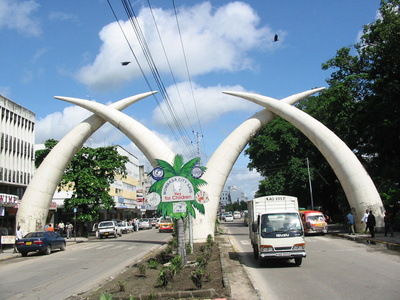
The Famous Mombasa Tusks
Surrounding the Old Town is the modern-day city with wide boulevards and an increasing number of high-rise buildings. The icon of the city is seen on Moi Avenue – twin pairs of elephant tusks made of aluminium built in 1952 to welcome the then Princess Elizabeth of England on her way to a Kenyan safari.
Walking around armed with ice-cold drinks is a good way to know the lay of the land. Be on the lookout for a surprisingly extensive forest of large baobab trees which are often found in ancient settlements along the coast,
Modern Mombasa Kenya is an industrial city. There are major oil refineries and there is a regrettable lack of beaches. The lure of the beaches on the northern and southern coasts will probably prove irresistible but the city is well worth a day’s exploration to catch a glimpse of how life was centuries ago.


 KES 14,350 PPS
KES 14,350 PPS

 KES 12,600 PPS
KES 12,600 PPS 



